Rod lens array and method of manufacturing the same
a technology of lens array and rod, which is applied in the field of rod lens array, can solve the problems of reducing optical properties, affecting the precision of arrangement of lens elements, and difficult handling of panel glass, so as to reduce non-filling failure, improve the clogging of resin, and remove the disturbance of arrangement
- Summary
- Abstract
- Description
- Claims
- Application Information
AI Technical Summary
Benefits of technology
Problems solved by technology
Method used
Image
Examples
example 1-1
[0051] After carbon black was added to an epoxy resin by using a phenol-based curing agent including a tris-hydroxyphenyl-methane skeleton to conduct blackening, a glass cloth was dipped therein to produce a prepreg. The prepreg was heated to 200° C. and pressed to produce a glass fiber reinforced epoxy resin panel having a thickness of about 0.95 mm, and the panel was cut in a predetermined size (349×380 mm). Unevenness of a surface of the glass fiber reinforced epoxy resin panel obtained in example 1-1 was improved, so that the surface roughness of the central line Ra was 0.3 μm and the maximum height Ry was 1.1 μm.
[0052] The rod lens arrays produced by using the glass fiber reinforced epoxy resin panel were randomly taken out, and the thickness variation was about 20 μm as a result of measuring the thickness precision. Furthermore, the maximum arrangement deviation was 15 μm as a result of measuring the arrangement precision of the rod lens arrays. The rod lens arrays were left ...
example 2-1
[0059] The silicone resin A used in Example 2-1 was an additional reaction type silicone resin having a viscosity of 1200 to 1400 mPa·s, to which 15 mass % of vinyl trimethoxysilane was added as a resin component. Furthermore, 10 mass % of a monodispersed spheric polymethylsyl sesquioxane having an average particle diameter of 25 μm, 4.0 mass % of carbon black as a light shielding agent, and 0.1 mass % of a curing retardant were added.
example 2-2
[0060] The silicone resin B used in Example 2-2 was an additional reaction type silicone resin having a viscosity of 1000 to 1100 mpa·s, to which 15 mass % of vinyl trimethoxysilane was added as a resin component. Furthermore, 10 mass % of a monodispersed spheric polymethylsyl sesquioxane having an average particle diameter of 25 μm, 4.0 mass % of carbon black as a light shielding agent, and 0.1 mass % of a curing retarding agent were added.
PUM
 Login to View More
Login to View More Abstract
Description
Claims
Application Information
 Login to View More
Login to View More - R&D
- Intellectual Property
- Life Sciences
- Materials
- Tech Scout
- Unparalleled Data Quality
- Higher Quality Content
- 60% Fewer Hallucinations
Browse by: Latest US Patents, China's latest patents, Technical Efficacy Thesaurus, Application Domain, Technology Topic, Popular Technical Reports.
© 2025 PatSnap. All rights reserved.Legal|Privacy policy|Modern Slavery Act Transparency Statement|Sitemap|About US| Contact US: help@patsnap.com



